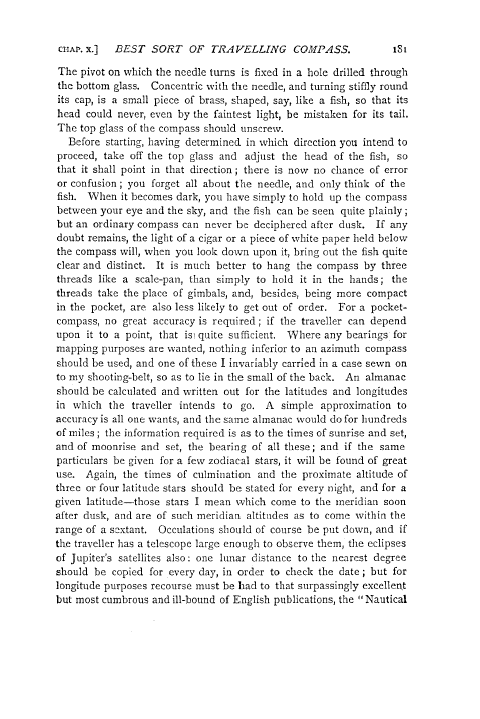c1-IA?. X.] BEST SORT OF TRAVELLING COMPASS. iSi
The pivot on which the needle turns is fixed in a hole drilled through the bottom glass. Concentric with the needle, and turning stiffly round its cap, is a small piece of brass, shaped, say, like a fish, so that its head could never, even by the faintest light, be mistaken for its tail. The top glass of the compass should unscrew.
Before starting, having determined in which direction you intend to proceed, take off the top glass and adjust the head of the fish, so that it shall point in that direction ; there is now no chance of error or confusion ; you forget all about the needle, and only think of the fish. When it becomes dark, you have simply to hold up the compass between your eye and the sky, and the fish can be seen quite plainly; but an ordinary compass can never be deciphered after dusk. If any doubt remains, the light of a cigar or a piece of white paper held below the compass will, when you look down upon it, bring out the fish quite clear and distinct. It is much better to hang the compass by three threads like a scale-pan, than simply to hold it in the hands ; the threads take the place of gimbals, and, besides, being more compact in the pocket, are also less likely to get out of order. For a pocketcompass, no great accuracy is required; if the traveller can depend upon it to a point, that is? quite sufficient. Where any bearings for mapping purposes are wanted, nothing inferior to an azimuth compass should be used, and one of these I invariably carried in a case sewn on to my shooting-belt, so as to lie in the small of the back. An almanac should be calculated and written out for the latitudes and longitudes in which the traveller intends to go. A simple approximation to accuracy is all one wants, and the same almanac would do for hundreds of miles; the information required is as to the times of sunrise and set, and of moonrise and set, the bearing of all these ; and if the same particulars be given for a few zodiacal stars, it will be found of great use. Again, the times of culmination and the proximate altitude of three or four latitude stars should be stated for every night, and for a given latitude-those stars I mean which come to the meridian soon after dusk, and are of such meridian altitudes as to come within the range of a sextant. Occulations should of course be put down, and if the traveller has a telescope large enough to observe them, the eclipses of Jupiter's satellites also: one lunar distance to the nearest degree should be copied for every day, in order to check the date; but for longitude purposes recourse must be had to that surpassingly excellent but most cumbrous and ill-bound of English publications, the "Nautical

